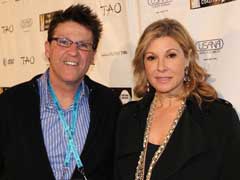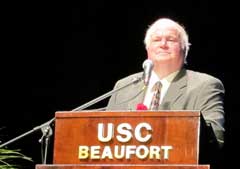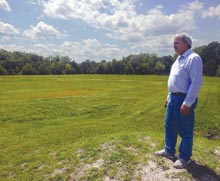 Why a tiny, cutting edge urban farm could be the biggest thing to hit Beaufort in decades
Why a tiny, cutting edge urban farm could be the biggest thing to hit Beaufort in decades
“The definitive relationships in the universe are… not competitive but interdependent. We can build one system only within another. We can have agriculture only within nature, and culture only within agriculture. At certain critical points these systems have to conform with one another or destroy one another.”
– Wendell Berry, The Unsettling of America: Culture and Agriculture
There’s a joke about an old farmer who wins a $100 million lottery. One day he and a young farmer are leaning on a fence surveying the vast horizon of drought parched row crops. After a lengthy silence the younger man asks, “Whatcha gonna do with all that money?”
His elder pauses a beat and replies, “Well, I ‘spose I’ll just keep farming till it’s all gone.”
That kills in Iowa. But they’re not laughing on the West Coast as a record-breaking drought drags into its fourth year. Conditions are classified as severe over nearly 95% of California, threatening another growing season and pushing up grocery prices across the nation. It’s the agricultural equivalent of the “butterfly effect.” For the rapidly growing local food movement, this is a sign of things to come and a harsh indicator of a deeply flawed system: a system utterly dependent on large-scale industrial agri-business methods proven to be ultimately inefficient and culturally destructive. Paul Brody wants to help change that system. And he wants to start with a farm in Beaufort.
A long time criminal mediator in North Carolina, shortly after arriving in Beaufort he 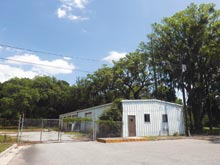 lobbied to change the law to allow mediation in South Carolina. “And he accomplished that,” says Fred Leyda. “We all thought, sure, when pigs fly. But he did it.” The Beaufort County Human Services Director began working with Brody about a year ago, shortly after Brody presented his plan to Mayor Billy Keyserling for a small, biodynamic urban farm and education center. According to the Biodynamic Association, biodynamics is “a spiritual-ethical-ecological approach to agriculture, food production and nutrition, and a potent force for change worldwide.”
lobbied to change the law to allow mediation in South Carolina. “And he accomplished that,” says Fred Leyda. “We all thought, sure, when pigs fly. But he did it.” The Beaufort County Human Services Director began working with Brody about a year ago, shortly after Brody presented his plan to Mayor Billy Keyserling for a small, biodynamic urban farm and education center. According to the Biodynamic Association, biodynamics is “a spiritual-ethical-ecological approach to agriculture, food production and nutrition, and a potent force for change worldwide.”
“When I came to the city with this idea I didn’t ask for money,” says Brody, “I asked for a place.”
Keyserling suggested the possibility of using a small piece of Southside Park, a 38-acre parcel in the Mossy Oaks community and former site of an old water treatment plant. The original buildings still sit abandoned in one corner of the property, windows smashed – vacant testaments to a decade of controversy and neighborhood struggles over what to do with the land. The property includes a forested area and large open tracts separated by a tidal creek. The proposed farm would make use of about six acres and renovate the derelict buildings into a barn, office space, and farm store. The farm proper would exist above ground in greenhouses surrounded by fencing planted to form a “green wall” of flowering edibles and ornamentals. The property’s history has ruined much of the soil for growing food, an appropriately ironic twist in the tale should the farm take root there.
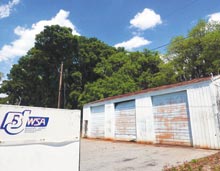 Brody, who’s been building and selling businesses since his teens, initially envisioned the project as a for-profit enterprise to hand down to the next generation. But when the next generation passed on the idea, he retooled the concept as a self-sustaining non-profit with a mission to feed, educate and incubate. The model is Will Allen’s Growing Power farms based in Brody’s hometown of Milwaukee. Since 1993 Allen’s hugely successful biodynamic concept has spread out to transform communities across the Midwest and bolstered a growing worldwide interest and agri-tourism industry. Proponents of Brody’s Beaufort Community Farm see the same sort of potential.
Brody, who’s been building and selling businesses since his teens, initially envisioned the project as a for-profit enterprise to hand down to the next generation. But when the next generation passed on the idea, he retooled the concept as a self-sustaining non-profit with a mission to feed, educate and incubate. The model is Will Allen’s Growing Power farms based in Brody’s hometown of Milwaukee. Since 1993 Allen’s hugely successful biodynamic concept has spread out to transform communities across the Midwest and bolstered a growing worldwide interest and agri-tourism industry. Proponents of Brody’s Beaufort Community Farm see the same sort of potential.
“It’s the first project I’ve seen that integrates all five areas that the Beaufort County Human Services Alliance is focused on through our Together For Beaufort County initiative,” says Leyda. “What we’ve come away with are five major concerns: education, economy, poverty, health and environment. And Paul’s project – even before it became a non-profit – integrates all of those focus areas.”
Leyda, who’s seen non-profits come and go, points out the potential impact of the educational and entrepreneurial aspects of Brody’s plan. He doesn’t see a downside to the project regardless of what happens with Southside Park.
“The location isn’t as important as the concept,” says Leyda. “Wherever Paul does this, it’s going to be really good for the neighborhood that gets it because it’s all about community building.
I can understand how people who don’t get the whole picture could see it as competitive, but his idea is to be able to generate enough revenue to give scholarships to local farmers to introduce some of these innovative techniques on their own property and increase their yield and make more money,” adds Leyda. “It’s definitely economic development rather than just a farm.”
Brody’s spent countless hours studying every aspect of the property, planning how to configure each component of the project to best make use of the elements. BCF is also negotiating to assume the upkeep of the city’s long-planned tree farm and the costly responsibility of park maintenance (currently a budgetary hardship for the city). BCF would also undertake a program of park re-nourishment and beautification. The Beaufort Community Farm is currently putting together a diverse board of directors and refining its mission. Brody will speak about the educational aspects of the farm during the May 19th Greendrinks meeting (5:30 – 7:00 pm at Plum’s). And the public is invited to meet the board and review the plans Thursday, May 21st at the TCL auditorium (see the box for details).
I recently toured the Southside Park site with Brody and sat down to talk about an opportunity some key community leaders consider too important to let slip away.
“I believe that equal access to healthy, affordable food should be a civil right – every bit as important as access to clean air, clean water, or the right to vote…. [Modern agro-business] has stripped people of the dignity of knowing how to provide for themselves on the most basic level. It has given us two very different food systems – one for the rich and another for the poor.”
–Will Allen, The Good Food Revolution: Growing Healthy Food, People, and Communities
HERDING DUCKS AND THE PRACTICAL APPLICATION OF BIODYNAMICS
Mark Shaffer: Why Beaufort, and why now?
Paul Brody: It’s something I’ve been thinking about for a long time and life just kind of got in the way. I’ve owned companies since I was 18 years old and those responsibilities always seemed to come first. But now that we’re here, it’s the perfect opportunity, the perfect place and the right time. The [biodynamic] movement has been around a while and it’s growing. This isn’t new. I’m not re-inventing the wheel. I’m just packaging it in a different way.
MS: This comes out of a belief that we’ve become utterly dependent on buying our 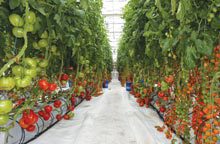 food. We’ve lost the ability to be self-sufficient?
food. We’ve lost the ability to be self-sufficient?
PB: We’ve lost a century of knowledge. We need to educate people on nutrition – how to prepare and preserve food, how to be self-sufficient. What would happen if suddenly no more trucks were rolling out of California because there’s no fuel or nothing to put in them? It’s too late to plant a garden then. You have to start now.
There’s an old Chinese proverb: The best time to plant a tree is 100 years ago, the second best time is now. We’ve been lulled into this sense of security by our industrial agriculture and when that bubble breaks who’s going to pick up the pieces. And nature is helping to break that bubble.
MS: How so?
PB: A farmer plants 1000 acres of corn as a mono-crop and this depletes the soil. Then he’s got to bring in petroleum-based fertilizers to make the soil fertile again. That’s not how nature does things. We’ve got to work with and mimic nature as best we can.
MS: The idea is to cooperate with it rather than defy it?
PB: Right. And when you do that it’s a whole relationship. And that’s what this farm is going to be. Every component goes together.
MS: For example?
PB: Rabbits. Our rabbits are only there to poop. And we collect it and add worms. They compost the rabbit manure, we make compost tea and use it to fertilize our crops and it’s natural. We’re mimicking nature.
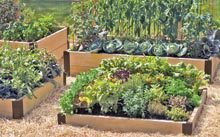 Herding ducks is another one. You can herd ducks. All you need is a stick and a flag. When we start to see slugs in the orchard we herd the ducks into the orchard and pretty soon, no more slugs.
Herding ducks is another one. You can herd ducks. All you need is a stick and a flag. When we start to see slugs in the orchard we herd the ducks into the orchard and pretty soon, no more slugs.
MS: And you get eggs in the bargain.
PB: It all works together. And we’ll create jobs – jobs for both skilled and teachable positions at the farm proper. But we can also create jobs with business opportunities. If somebody comes to us who wants to start a pasture poultry operation on leased land somewhere, we can work with them. Work with our chickens for a while and then we can either direct assist them with a grant of some kind to get started or we can help find money. Once we do that we’ve helped create a local business and the money stays here.
That’s a big part of this thing – creating an environment where people can do that. If somebody wants to do pasture raised pork or put up a greenhouse and grow whatever, then let’s help them achieve that. We can cooperate, work together and create this whole system.
MS: What do you say to those who perceive this as just more competition for local farmers?
PB: Farming isn’t a competition. Farming should be cooperation – a cooperative effort between farmers. Our goals are marked by collaboration and education: if a farmer comes to us and says he really likes what we’re doing – maybe he’d like to try hydroponics – then we’d say, “Well, come on over and we’ll teach you everything you need to know about it. And if you’re ready, willing and able we will help you get set up.”
We have to be self-sustainable. We have to make enough money to pay the bills. 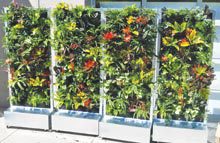 And we have a built in capital expense for funding projects like this. Our mission is not to horde money. Our mission is to take the [fiscal] overage and pass it on as business opportunities and donate the extra crops to food banks.
And we have a built in capital expense for funding projects like this. Our mission is not to horde money. Our mission is to take the [fiscal] overage and pass it on as business opportunities and donate the extra crops to food banks.
MS: Essentially pay it forward.
PD: That’s what we have to do as a non-profit. For example, local farmers could pool resources to create value-added products. It’s hard for one farmer to do that alone. I’d like to be able to sell value-added products in our farm store. My wife makes a really great salsa and we can grow to her recipe. So we could take that and turn it into a value-added product.
MS: That’s a very cool aspect of this concept. You can tailor your crops for a specific product idea. Literally growing salsa.
PB: My daughter’s the manager for Duke Wellness at Duke University. And we were talking about this and came up with the idea of designing the farm around 20 recipes so that at any time at least 5 of them were always available. Go out and grab whatever you need and it’s fresh, healthy and it’s not expensive. We designed them so that a family of four can make a recipe for under $10. That’s what we’re doing. We’re going to grow to the recipes.
MS: And nearly all of this is greenhouse production.
PB: One greenhouse at 75 percent production can grow 80,000 pounds of tomatoes.
MS: Over the course of a year?
PB: Right. Everyday that works out to about a dozen 20-pound boxes. 80,000 pounds sounds like a lot but it’s not that much on a daily basis. There’s a farm in North Carolina putting in greenhouses to grow hydroponic tomatoes and they’re estimating 90,000 tons a year. So our little 80,000 pounds isn’t much. And if we can’t sell it, why not process it? Why not make ketchup or spaghetti sauce and sell it as a local product?
MS: Break down the basic concept of biodynamics for those of us unfamiliar with it.
PB: It’s looking at the farm as a single unit. Everything on the farm works together and all the nutrients on the farm stay on the farm. We make our own compost. We’ll have to bring some in initially to get started, but we’ll make sure it’s good. From then on we’ll make our own.
You have to know how things work. We can use coffee grounds in the compost but we can’t take wood chips from a walnut tree and toss it in because there’s a toxin in walnut that inhibits growth in other plants.
MS: Not something most people would know.
PB: With biodynamics you get into the intricacies of that sort of thing. What affects something else? It even comes down to whether the [wood chips] came from branches or trunks because they decompose in different ways. You have to know this stuff.
If we’re supplying a restaurant with eggs or whatever, when we deliver we also take back the stuff they didn’t use. We know it’s coming back. We keep the system going. Our chickens are working chickens. They’re not there to lay eggs. The eggs are by-products of the system. The chickens are a big part of our micro-greens. Without them it doesn’t work. You harvest 300 trays a day and throw what’s left on the compost pile it’s going to take a while to decompose. You take those same trays and give them to the chickens it’s like giving them candy. They’ll rip them apart and then they poop (laughs). Everything poops. It’s all about poop.
MS: It’s the key to everything on a farm.
PB: It is. And when our chickens work this way we don’t have to pay someone to tear those things apart and t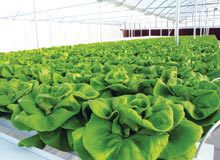 hen wait for it to break down. A month later that stuff’s back in the trays in the greenhouse. We recycle everything. And that’s what biodynamics is about.
hen wait for it to break down. A month later that stuff’s back in the trays in the greenhouse. We recycle everything. And that’s what biodynamics is about.
MS: We’ve barely scratched the surface of the educational aspect of this project, but the BCF could also serve as a hub for agro-tourism, which is growing right along with eco-tourism. Will Allen’s proved that in Milwaukee.
PB: People come from all over the world to see his farm and learn about what he’s doing. And we want that here. There’s nothing like this in Atlanta, Savannah, Raleigh, Charlotte, or Jacksonville. The whole region’s basically barren of this sort of thing. So when someone in Atlanta or Charlotte decides they want to do something like this, where are they going to come? We want them to come to Beaufort. The have to stay somewhere, they have to eat somewhere and they’re going to stay for a week and see what we’re doing. They’ll work alongside with us.
I keep track of everything I do [on this project]. Eventually, I’ll write a book or a manual on this available for anyone who wants it. If you want to take this project to Atlanta you’d want to scale it to Atlanta – scale it up. But if you’re doing it in Walterboro you want to scale it down.
MS: It’s all conceived and executed as a scaleable, learnable template.
PB: Yeah. What we’re building is a template for the region. [The plans include] an education greenhouse where we can have classes and teach farm technique, nutrition and various things. Maybe TCL’s new ag-science program can meet there a couple of times a week? We’re also planning an experimental greenhouse, which is also our incubator for the business opportunities. If you have an idea for [a new vertical farming system] we can give you the space to do it. If it works we’ll incorporate it into our program or you can take it on the road.
Our vertical garden for year round strawberry production is 9600 plants in moveable greenhouses. They’re on tracks. On a nice day like this, we open the greenhouse up to the sun. On a bad day we close it up. In the winter we generate a little heat [with a system I’ve designed] at close to zero cost.
MS: And that’s a huge part of what makes this project so attractive. Once the system’s in place it runs at virtually no cost. All the components work together to fuel the whole – it’s a living thing.
PB: Right. I was consulting on a [greenhouse farm] in Hilton Head this morning. [The client] was talking about buying compost and I told her if you have to buy compost, you’re going to go broke. If you’re going to buy fertilizer, you’re going to go broke. Why not have some rabbits making it for you? There’s no cost because you’re feeding them the scraps of what you grow. They’d much rather have those than “pelletized” alfalfa. You don’t know what’s in that. It could have other rabbits in it. You never know.
ETCETERA
Learn more about this project online at BeaufortCommunityFarm.org
Dig into Biodynamics at www.biodynamics.com and check out Will Allen’s Milwaukee operation at www.growingpower.org
Pictured Above:
1) Paul Brody at proposed site of Beaufort Community Farm in Southside Park
2) Former BJWSA Shed to be converted to office and farm store
3) Former BSA Shed to be converted to workable barn
4) Hydroponic tomatoes
5) Raised beds
6) Vertical garden
7) Hydroponic lettuce


